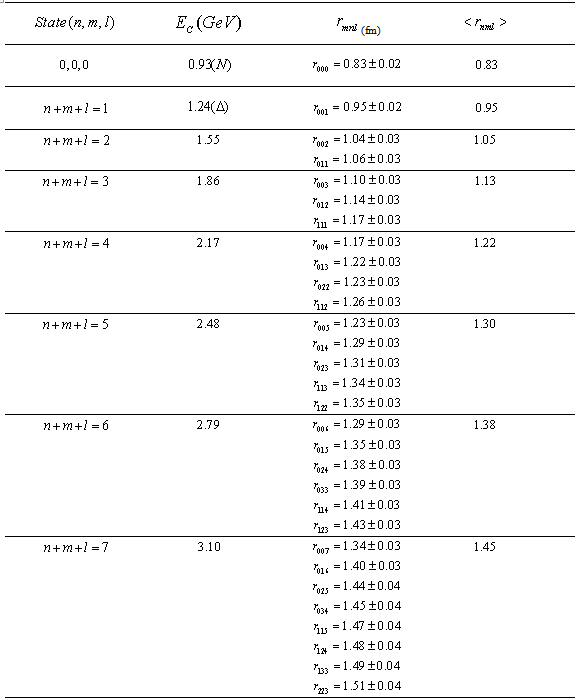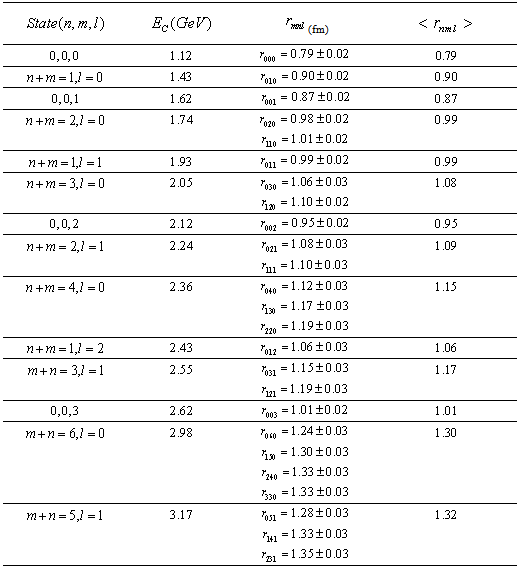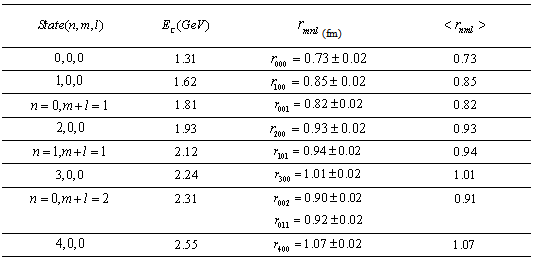| [1] | C. Gobbi, S. Boffi, and D. O. Riska, “Mean square radii of hyperons in the bound-state soliton model”, Nuclear Physics A, vol. 547, p. 633, 1992. |
| [2] | A. J. Buchmann and R. F. Lebed, “Large  , constituent quarks, and , constituent quarks, and  charge radii”, Physical Review D, vol. 62, p. 096005, 2000. charge radii”, Physical Review D, vol. 62, p. 096005, 2000. |
| [3] | A. J. Buchmann and R. F. Lebed, “Structure of strange baryons”, Physical Review D, vol. 67, p. 016002, 2003. |
| [4] | S. Cheedket, V. E. Lyuvovitskij, T. Gutsche, A. Faessler, K. Pumsa-ard, and Y. Yan, “Electromagnetic form factors of the baryon octet in the perturbative chiral quark model”, European Physics Journal A, vol. 20, p. 317, 2004. |
| [5] | S. J. Puglia, M. J. Ramsey-Musolf, and Shi-Lin Zhu, “Octet baryon charge radii, chiral symmetry, and decuplet intermediate states”, Physical Review D, vol 63, p. 034014, 2001. |
| [6] | D. Arndt and B. C. Tiburzi, “Charge radii of the meson and baryon octets in quenched and partially quenched chiral perturbation theory”, Physical Review D, vol. 68, p. 094501, 2003. |
| [7] | L. S. Geng, J. M. Camalich, and M. J. V. Vacas, “Electromagnetic structure of the lowest-lying decuplet resonances in covariant chiral perturbation theory”, Physical Review D, vol. 80, p. 034027, 2009. |
| [8] | P. Wang, D. B. Leinweber, A. W. Thomas, and R. D. Young, “Chiral extrapolation of octet-baryon charge radii”, Physical Review D, vol. 79, p. 094001, 2009. |
| [9] | S. Boinepalli, D. B. Leinweber, P. J. Moran, A. G. Willimas, J. M. Zanotti, and J. B. Zhang, “Electromagnetic structure of decuplet baryons in the chiral regime”, Physical Review D, vol. 80, p. 054505, 2009. |
| [10] | T. Sekihara, T. Hyodo, and D. Jido, “Electromagnetic Mean Squared Radii of  in Meson-baryon Dynamics with Chiral Symmetry”, Progress of Theoretical Physics supplement, vol. 174, p. 266, 2008. in Meson-baryon Dynamics with Chiral Symmetry”, Progress of Theoretical Physics supplement, vol. 174, p. 266, 2008. |
| [11] | N. Sharma and H. Dahiya, “Charge radii of octet and decuplet baryons”, AIP Conference Proceedings, vol. 1388, issue 1, p. 458, 2011. |
| [12] | J. J. Murphy, II, Y. M. Shin, and D. M. Skopik, “Proton form factor from 0.15 to 0.79 fm2”, Physical Review. C, vol. 9, p. 2125, 1974. |
| [13] | B. Povh and J. Hüfner, “Geometric interpretation of hadron-proton total cross sections and a determination of hadronic radii”, Physical Review Letters, vol. 58, p. 1612, 1987. |
| [14] | I. Eschich et al. (SELEX Collaboration), “Measurement of the  charge radius by charge radius by  -electron elastic scattering”, Physics Letters B, vol. 522, p. 233, 2001. -electron elastic scattering”, Physics Letters B, vol. 522, p. 233, 2001. |
| [15] | M. E. de Souza, “Calculation of the energy levels and sizes of baryons with a noncentral harmonic potential”, arXiv: hep-ph/0209064. |
| [16] | M. E. de Souza, “Calculation of almost all energy levels of baryons”, Papers in Physics, vol. 3, p. 030003, 2011. |
| [17] | I. V. Gorelov(CDF Collaboration), “Evidence for the bottom baryon resonance  with the CDF II detector”, arXiv: hep-ex/1301.0949. with the CDF II detector”, arXiv: hep-ex/1301.0949. |
| [18] | J. Beringer et al. (PDG), Physical Review E, vol. 86, p. 010001, 2012. |

 .
.
 expansion[2,3], chiral perturbation theory[4-7], lattice QCD [8,9], meson-baryon dynamics with chiral symmetry[10], chiral constituent quark model (
expansion[2,3], chiral perturbation theory[4-7], lattice QCD [8,9], meson-baryon dynamics with chiral symmetry[10], chiral constituent quark model ( CQM)[11] etc. However, none of these models has derived a formula for the radii of baryons. On the experimental side there are a couple of important works that have reported the radii of the ground states of some baryons[12,13,14].The present work is an updated version of the pre-print[15]. It is based on reference[16] which calculated most energy levels of baryons by means of two simple formulas (one in Cartesian coordinates and another one in polar cylindrical coordinates) with which we can predict levels yet to be found. The formulas do not apply to levels resulting from hadronic molecules. One of the energy levels predicted was the 1st excited state of
CQM)[11] etc. However, none of these models has derived a formula for the radii of baryons. On the experimental side there are a couple of important works that have reported the radii of the ground states of some baryons[12,13,14].The present work is an updated version of the pre-print[15]. It is based on reference[16] which calculated most energy levels of baryons by means of two simple formulas (one in Cartesian coordinates and another one in polar cylindrical coordinates) with which we can predict levels yet to be found. The formulas do not apply to levels resulting from hadronic molecules. One of the energy levels predicted was the 1st excited state of  (energy of 5.93 GeV) which has recently been found by CDF[17] with energy equal to
(energy of 5.93 GeV) which has recently been found by CDF[17] with energy equal to  MeV.
MeV. 
 and
and  are the masses of quarks. On the other hand it is well known that the average potential energy of a harmonic oscillator is half of the total energy, that is,
are the masses of quarks. On the other hand it is well known that the average potential energy of a harmonic oscillator is half of the total energy, that is,
 but since the 3 quarks are in a plane and as there are two spatial degrees of freedom in the plane for each quark, we have
but since the 3 quarks are in a plane and as there are two spatial degrees of freedom in the plane for each quark, we have
 in which
in which  and
and  are the two orthogonal directions. Eq. (1) above was obtained considering three independent oscillators. Thus we can make the association
are the two orthogonal directions. Eq. (1) above was obtained considering three independent oscillators. Thus we can make the association 


 for the ground state of
for the ground state of  and its agreement with the experimental value.
and its agreement with the experimental value.  were taken from Particle Data Group[18] as
were taken from Particle Data Group[18] as  GeV,
GeV,  GeV,
GeV,  GeV,
GeV,  GeV, and
GeV, and  GeV. In the calculations below the average value
GeV. In the calculations below the average value  was calculated by performing the average of the different
was calculated by performing the average of the different  taking into account the several possible values for
taking into account the several possible values for  .
. ,
,  ,
, 
 , and thus, as calculated above
, and thus, as calculated above 
 GeV and the experimental value
GeV and the experimental value  fm[14] for the proton radius, we obtain
fm[14] for the proton radius, we obtain  GeV/fm2. Therefore, we have
GeV/fm2. Therefore, we have
 and
and 
 , and thus, according to Eq. (6) we have
, and thus, according to Eq. (6) we have 
 fm for the ground state of
fm for the ground state of  [14] and the above value of
[14] and the above value of  GeV/fm2, we obtain from Eq. (9)
GeV/fm2, we obtain from Eq. (9)  GeV/fm2. Therefore, the equation for the radii of these baryons is given by
GeV/fm2. Therefore, the equation for the radii of these baryons is given by 


 GeV we obtain from Eq. (11)
GeV we obtain from Eq. (11)  fm which is very close to the experimental value of
fm which is very close to the experimental value of  fm[6]. This result confirms the validity of the general formula
fm[6]. This result confirms the validity of the general formula Using this formula to the experimentally observed levels (in terms of energy) we obtain the values displayed on Table 3 below.
Using this formula to the experimentally observed levels (in terms of energy) we obtain the values displayed on Table 3 below. 

 fm. The calculation of the other levels produce Table 4 below.
fm. The calculation of the other levels produce Table 4 below. . Since the formula for the radius was deduced from the expression for the energy in Cartesian coordinates there is not a way at the moment of identifying the radii in terms of
. Since the formula for the radius was deduced from the expression for the energy in Cartesian coordinates there is not a way at the moment of identifying the radii in terms of  and
and  . On the other hand we observe that within the same
. On the other hand we observe that within the same  level the radii do not change much and, thus, within the same energy level, the radii should not depend much on
level the radii do not change much and, thus, within the same energy level, the radii should not depend much on  . Of course, high values of the energy allow high values of
. Of course, high values of the energy allow high values of  and
and  as can be seen on Table 2 and Table 3 of reference[16], and thus the radius tend to increase with
as can be seen on Table 2 and Table 3 of reference[16], and thus the radius tend to increase with  and
and  , but there is not a simple relation between the radius and the value of
, but there is not a simple relation between the radius and the value of  or the value of
or the value of  .
. Abstract
Abstract Reference
Reference Full-Text PDF
Full-Text PDF Full-text HTML
Full-text HTML have the same error bars
have the same error bars
 have the same error bars
have the same error bars
 have the same error bars
have the same error bars
 have the same error bars
have the same error bars
 , constituent quarks, and
, constituent quarks, and  charge radii”, Physical Review D, vol. 62, p. 096005, 2000.
charge radii”, Physical Review D, vol. 62, p. 096005, 2000. in Meson-baryon Dynamics with Chiral Symmetry”, Progress of Theoretical Physics supplement, vol. 174, p. 266, 2008.
in Meson-baryon Dynamics with Chiral Symmetry”, Progress of Theoretical Physics supplement, vol. 174, p. 266, 2008. charge radius by
charge radius by  -electron elastic scattering”, Physics Letters B, vol. 522, p. 233, 2001.
-electron elastic scattering”, Physics Letters B, vol. 522, p. 233, 2001. with the CDF II detector”, arXiv: hep-ex/1301.0949.
with the CDF II detector”, arXiv: hep-ex/1301.0949.